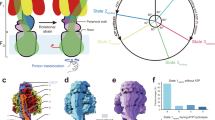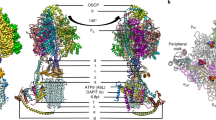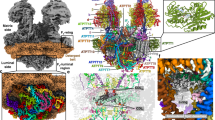Abstract
ATP, the universal energy currency of cells, is produced by F-type ATP synthases, which are ancient, membrane-bound nanomachines. F-type ATP synthases use the energy of a transmembrane electrochemical gradient to generate ATP by rotary catalysis. Protons moving across the membrane drive a rotor ring composed of 8–15 c-subunits1. A central stalk transmits the rotation of the c-ring to the catalytic F1 head, where a series of conformational changes results in ATP synthesis2. A key unresolved question in this fundamental process is how protons pass through the membrane to drive ATP production. Mitochondrial ATP synthases form V-shaped homodimers in cristae membranes3. Here we report the structure of a native and active mitochondrial ATP synthase dimer, determined by single-particle electron cryomicroscopy at 6.2 Å resolution. Our structure shows four long, horizontal membrane-intrinsic α-helices in the a-subunit, arranged in two hairpins at an angle of approximately 70° relative to the c-ring helices. It has been proposed that a strictly conserved membrane-embedded arginine in the a-subunit couples proton translocation to c-ring rotation4. A fit of the conserved carboxy-terminal a-subunit sequence places the conserved arginine next to a proton-binding c-subunit glutamate. The map shows a slanting solvent-accessible channel that extends from the mitochondrial matrix to the conserved arginine. Another hydrophilic cavity on the lumenal membrane surface defines a direct route for the protons to an essential histidine–glutamate pair5. Our results provide unique new insights into the structure and function of rotary ATP synthases and explain how ATP production is coupled to proton translocation.
This is a preview of subscription content, access via your institution
Access options
Subscribe to this journal
Receive 51 print issues and online access
$199.00 per year
only $3.90 per issue
Buy this article
- Purchase on Springer Link
- Instant access to full article PDF
Prices may be subject to local taxes which are calculated during checkout




Similar content being viewed by others
Accession codes
Primary accessions
Electron Microscopy Data Bank
Protein Data Bank
Referenced accessions
Protein Data Bank
Data deposits
The electron cryomicroscopy map of the Polytomella sp. proton-driven ATP synthase dimer has been deposited in the Electron Microscopy Data Bank under accession number EMD-2852. Raw image data have been deposited in the European Bioinformatics Institute Electron Microscopy Pilot Image Archive (http://www.ebi.ac.uk/pdbe/emdb/empiar/) under accession number EMPIAR-10023.
References
Pogoryelov, D. et al. Engineering rotor ring stoichiometries in ATP synthases. Proc. Natl Acad. Sci. USA 109, E1599–E1608 (2012)
Abrahams, J. P., Leslie, A. G., Lutter, R. & Walker, J. E. Structure at 2.8 Å resolution of F1 ATPase from bovine heart mitochondria. Nature 370, 621–628 (1994)
Davies, K. M. et al. Macromolecular organization of ATP synthase and complex I in whole mitochondria. Proc. Natl Acad. Sci. USA 108, 14121–14126 (2011)
Mitome, N. et al. Essential arginine residue of the Fo-a subunit in FoF1-ATP synthase has a role to prevent the proton shortcut without c-ring rotation in the Fo proton channel. Biochem. J. 430, 171–177 (2010)
Cain, B. D. & Simoni, R. D. Interaction between Glu-219 and His-245 within the a-subunit of F1Fo-ATPase in Escherichia coli. J. Biol. Chem. 263, 6602–6612 (1988)
van Lis, R., Mendoza-Hernández, G., Groth, G. & Atteia, A. New insights into the unique structure of the F0F1-ATP synthase from the chlamydomonad algae Polytomella sp. and Chlamydomonas reinhardtii. Plant Physiol. 144, 1190–1199 (2007)
Symersky, J. et al. Structure of the c(10) ring of the yeast mitochondrial ATP synthase in the open conformation. Nature Struct. Mol. Biol. 19, 485–491 (2012)
Rees, D. M., Leslie, A. G. & Walker, J. E. The structure of the membrane extrinsic region of bovine ATP synthase. Proc. Natl Acad. Sci. USA 106, 21597–21601 (2009)
Andrade, M. A., Petosa, C., O’Donoghue, S. I., Muller, C. W. & Bork, P. Comparison of ARM and HEAT protein repeats. J. Mol. Biol. 309, 1–18 (2001)
Jiang, W. & Fillingame, R. H. Interacting helical faces of subunits a and c in the F1F0 ATP synthase of Escherichia coli defined by disulfide cross-linking. Proc. Natl Acad. Sci. USA 95, 6607–6612 (1998)
Moore, K. J. & Fillingame, R. H. Structural interactions between transmembrane helices 4 and 5 of subunit a and the subunit c ring of Escherichia coli ATP synthase. J. Biol. Chem. 283, 31726–31735 (2008)
Hakulinen, J. K. et al. A structural study on the architecture of the bacterial ATP synthase Fo motor. Proc. Natl Acad. Sci. USA 109, E2050–E2056 (2012)
Lau, W. C. Y. & Rubinstein, J. L. Subnanometre-resolution structure of the intact Thermus thermophilus H+-driven ATP synthase. Nature 481, 214–218 (2012)
Schwem, B. E. & Fillingame, R. H. Cross-linking between helices within subunit a of Escherichia coli ATP synthase defines the transmembrane packing of a four-helix bundle. J. Biol. Chem. 281, 37861–37867 (2006)
Senes, A., Engel, D. E. & DeGrado, W. F. Folding of helical membrane proteins: the role of polar, GxxxG-like and proline motifs. Curr. Opin. Struct. Biol. 14, 465–479 (2004)
Hoppe, J., Schairer, H. U., Friedl, P. & Sebald, W. An Asp-Asn substitution in the proteolipid subunit of the ATP-synthase from Escherichia coli leads to a non-functional proton channel. FEBS Lett. 145, 21–29 (1982)
Hatch, L. P., Cox, G. B. & Howitt, S. M. The essential arginine residue at position 210 in the a subunit of the Escherichia coli ATP synthase can be transferred to position 252 with partial retention of activity. J. Biol. Chem. 270, 29407–29412 (1995)
Angevine, C. A. & Fillingame, R. H. Aqueous access channels in subunit a of rotary ATP synthase. J. Biol. Chem. 278, 6066–6074 (2003)
Pogoryelov, D. et al. Microscopic rotary mechanism of ion translocation in the Fo complex of ATP synthases. Nature Chem. Biol. 6, 891–899 (2010)
Moore, K. J., Angevine, C. A., Vincent, O. D., Schwem, B. E. & Fillingame, R. H. The cytoplasmic loops of subunit a of Escherichia coli ATP synthase may participate in the proton translocating mechanism. J. Biol. Chem. 283, 13044–13052 (2008)
Steed, P. R. & Fillingame, R. H. Residues in the polar loop of subunit c in Escherichia coli ATP synthase function in gating proton transport to the cytoplasm. J. Biol. Chem. 289, 2127–2138 (2014)
Junge, W., Lill, H. & Engelbrecht, S. ATP synthase: an electrochemical transducer with rotatory mechanics. Trends Biochem. Sci. 22, 420–423 (1997)
Matthies, D. et al. High-resolution structure and mechanism of an F/V-hybrid rotor ring in a Na+-coupled ATP synthase. Nature Commun. 5, http://dx.doi.org/10.1038/ncomms6286 (2014)
van Lis, R., González-Halphen, D. & Atteia, A. Divergence of the mitochondrial electron transport chains from the green alga Chlamydomonas reinhardtii and its colorless close relative Polytomella. Biochim. Biophys. Acta 1708, 23–34 (2005)
Atteia, A., van Lis, R., Ramírez, J. & González-Halphen, D. Polytomella spp. growth on ethanol: extracellular pH affects the accumulation of mitochondrial cytochrome c550 . Eur. J. Biochem. 267, 2850–2858 (2000)
Vázquez-Acevedo, M. et al. The mitochondrial ATP synthase of chlorophycean algae contains eight subunits of unknown origin involved in the formation of an atypical stator-stalk and in the dimerization of the complex. J. Bioenerg. Biomembr. 38, 271–282 (2006)
Villavicencio-Queijeiro, A. et al. The fully-active and structurally-stable form of the mitochondrial ATP synthase of Polytomella sp. is dimeric. J. Bioenerg. Biomembr. 41, 1–13 (2009)
Mills, D. J., Vitt, S., Strauss, M., Shima, S. & Vonck, J. De novo modeling of the F420-reducing [NiFe]-hydrogenase from a methanogenic archaeon by cryo-electron microscopy. eLife 2, e00218 (2013)
Allegretti, M., Mills, D. J., McMullan, G., Kühlbrandt, W. & Vonck, J. Atomic model of the F420-reducing [NiFe] hydrogenase by electron cryo-microscopy using a direct electron detector. eLife 3, e01963 (2014)
Li, X. et al. Electron counting and beam-induced motion correction enable near-atomic-resolution single-particle cryo-EM. Nature Methods 10, 584–590 (2013)
Mindell, J. A. & Grigorieff, N. Accurate determination of local defocus and specimen tilt in electron microscopy. J. Struct. Biol. 142, 334–347 (2003)
Scheres, S. H. W. RELION: implementation of a Bayesian approach to cryo-EM structure determination. J. Struct. Biol. 180, 519–530 (2012)
Wong, W. et al. Cryo-EM structure of the Plasmodium falciparum 80S ribosome bound to the anti-protozoan drug emetine. eLife 3, e3080 (2014)
Ludtke, S. J., Baldwin, P. R. & Chiu, W. EMAN: semiautomated software for high-resolution single-particle reconstructions. J. Struct. Biol. 128, 82–97 (1999)
Davies, K. M., Anselmi, C., Wittig, I., Faraldo-Gomez, J. D. & Kuhlbrandt, W. Structure of the yeast F1Fo-ATP synthase dimer and its role in shaping the mitochondrial cristae. Proc. Natl Acad. Sci. USA 109, 13602–13607 (2012)
Scheres, S. H. W. Beam-induced motion correction for sub-megadalton cryo-EM particles. eLife 3, e03665 (2014)
Chen, S. et al. High-resolution noise substitution to measure overfitting and validate resolution in 3D structure determination by single particle electron cryomicroscopy. Ultramicroscopy 135, 24–35 (2013)
Kucukelbir, A., Sigworth, F. J. & Tagare, H. D. Quantifying the local resolution of cryo-EM density maps. Nature Methods 11, 63–65 (2014)
Tang, G. et al. EMAN2: an extensible image processing suite for electron microscopy. J. Struct. Biol. 157, 38–46 (2007)
Larkin, M. A. et al. Clustal W and Clustal X version 2.0. Bioinformatics 23, 2947–2948 (2007)
Schroeder, G. F., Brunger, A. T. & Levitt, M. Combining efficient conformational sampling with a deformable elastic network model facilitates structure refinement at low resolution. Structure 15, 1630–1641 (2007)
Pettersen, E. F. et al. UCSF Chimera: a visualisation system for exploratory research and analysis. J. Comput. Chem. 25, 1605–1612 (2004)
Wada, T., Long, J. C., Zhang, D. & Vik, S. B. A novel labeling approach supports the five-transmembrane model of subunit a of the Escherichia coli ATP synthase. J. Biol. Chem. 274, 17353–17357 (1999)
Careaga, C. L. & Falke, J. J. Thermal motions of surface alpha-helices in the D-galactose chemosensory receptor: detection by disulfide trapping. J. Mol. Biol. 226, 1219–1235 (1992)
Vincent, O. D., Schwem, B. E., Steed, P. R., Jiang, W. & Fillingame, R. H. Fluidity of structure and swiveling of helices in the subunit c ring of Escherichia coli ATP synthase as revealed by cysteine-cysteine cross-linking. J. Biol. Chem. 282, 33788–33794 (2007).
Acknowledgements
We thank T. Meier and J. D. Faraldo-Gómez for discussions and reading the manuscript. Ö. Yildiz and J. F. Castillo-Hernandez provided computer support. This work was funded by the Max Planck Society (M.A., N.K., D.J.M., J.V., K.M.D., W.K.) and the Deutsche Forschungsgemeinschaft Cluster of Excellence Frankfurt ‘Macromolecular Complexes’ (K.M.D., W.K.).
Author information
Authors and Affiliations
Contributions
K.M.D., M.A. and W.K. designed the experiments. N.K. purified the protein. M.A., K.M.D., N.K. and D.J.M. collected images. M.A., N.K., K.M.D., J.V. and D.J.M. processed data. K.M.D., M.A., J.V. and W.K. analysed the data and wrote the paper.
Corresponding authors
Ethics declarations
Competing interests
The authors declare no competing financial interests.
Extended data figures and tables
Extended Data Figure 1 Oligomycin-sensitive ATPase activity.
ATPase assays27 performed with the Polytomella ATP synthase dimers used for electron cryomicroscopy data collection indicated high activity of 6–8 units per milligram protein, close to the reported activity for this complex27. ATPase activity was ∼90% inhibited by oligomycin, indicating that the F1Fo complex is coupled. The vertical lines indicate addition of dodecyl maltoside detergent to initiate the reaction. Measurements were performed in triplicates for each purification.
Extended Data Figure 2 Projection images of the Polytomella F-type ATP synthase dimer.
a, Typical electron cryo-micrograph of dimers in vitrified buffer recorded at 2.5 µm underfocus. b, Two-dimensional class averages and (c) corresponding projection images calculated from the final three-dimensional volume. d, Angular distribution of projection images used for three-dimensional reconstruction. ATP synthase dimers are oriented randomly in the thin layer of vitrified buffer. Scale bar in a, 50 nm.
Extended Data Figure 3 Local resolution estimates.
a, The unfiltered electron cryomicroscopy map was analysed with the programme ResMap38 to assess local resolution. The catalytic F1 head (red to green) is less well-ordered than the peripheral stalk and the membrane-embedded a-subunit (green to blue), as indicated by the rainbow colour code on the left. The insets show cross-sections through the density at the levels indicated on the right. b, Fourier shell correlation curves calculated from two independently refined data sets after soft masking. The resolution was 7.0 Å for the whole complex (red), 7.4 Å for the F1/c-ring complex (blue mask and curve) and 6.2 Å for the peripheral stalk and a-subunit (yellow mask and curve).
Extended Data Figure 4 Resolution of unsymmetrized map.
Side view (a) and top view (b) of the dimer map refined without imposing c2 symmetry (blue). c, The gold-standard Fourier shell correlation curve indicates a resolution of 8.0 Å for the unsymmetrized map, which shows all essential features of the Polytomella dimer, including c2 symmetry.
Extended Data Figure 5 Horizontal helices in the three-dimensional map and in two-dimensional projection.
a, Section of the three-dimensional map showing a side view of the c10-ring on the left and the a-subunit on the right. b, A slice of the three-dimensional map volume indicated in a shows the horizontal helices clearly. c, In a two-dimensional map generated by projecting the three-dimensional map volume in a along the indicated direction (arrow), the long horizontal helices are in effect invisible, whereas the vertical c-ring helices stand out clearly. Scale bar, 10 Å.
Extended Data Figure 6 Sequence alignment of about 120 C-terminal subunit a residues.
Sequences of bacterial (blue), mitochondrial (red) and chloroplast (green) F-type ATP synthases are compared. The interchangeable residue pairs aR239/aQ295 and aE288/aH248 are dark blue and green, respectively; sequences of helices fitted in Fig. 2b are light blue. The black arrowhead marks the strictly conserved arginine essential for coupled proton translocation. Red, prolines; magenta, solvent-exposed residues18,43; green, residues that crosslink to the c-ring10,11. Identical (★) or similar (‘.’ or ‘:’) residues are indicated.
Extended Data Figure 7 Subunit a and c crosslinking distances.
Pairs of a- and c-subunit residues crosslinked in E. coli using (a) zero-length crosslinkers10 and (b) bis-MTS reagents11. Tabulated distances were measured between beta carbons of residues in the modelled a-subunit helices and Saccharomyces c-ring helices fitted to the map. Zero-length crosslinks can be considerably shorter than crystallographic distances44,45, most probably as a result of thermal motion during the long incubation times required for crosslinking10. Nevertheless, the inter-residue distances in our model agree with the E. coli crosslinking data within reasonable margins, allowing for species differences between bacterial and mitochondrial ATP synthases.
Supplementary information
Supplementary Information
This file contains a Supplementary Discussion. (PDF 125 kb)
Mitochondrial ATP synthase dimer map
Cryo-EM map of the Polytomella mitochondrial ATP synthase dimer, highlighting the helix-turn helix pair (blue) and Armadillo repeat-like protein (pink) at the dimer interfaces. (MOV 20962 kb)
a-subunit structure
Zoomed-in view of membrane domains of one protomer showing the structure and orientation of the a-subunit (blue) to the c10-ring (yellow). (MOV 8181 kb)
Aqueous half-channels
Zoomed-in view of membrane region showing the two aqueous cavities. c-ring (yellow); a-subunit (blue); proposed interaction site of the a- and c-subunits (dark blue); proposed position of interchangeable residue pair aE288/aH248 (light green). The 1σ density threshold indicates the detergent shell (pink mesh). (MOV 25921 kb)
Solvent-exposed residues in the matrix cavity
Residues of the E. coli a subunit equivalent to Polytomella a225, 226, 228, 229, 231, 232, 235, 303 and 306-30820,43, as well as c-ring residues equivalent to Polytomella c44-6621 have been shown to be solvent exposed by cysteine mutagenesis. In our model, residues a225-235 (red), a303-308 (orange) and c44-66 (green) line the aqueous matrix cavity observed in the EM map of the Polytomella ATP synthase dimer. Thus our model is in excellent agreement with published biochemical studies on the solvent accessibility of a-subunit residues. Blue, a-subunit; yellow, c-ring; pink mesh, detergent shell; dark blue, location of conserved arginine. (MOV 9436 kb)
Rights and permissions
About this article
Cite this article
Allegretti, M., Klusch, N., Mills, D. et al. Horizontal membrane-intrinsic α-helices in the stator a-subunit of an F-type ATP synthase. Nature 521, 237–240 (2015). https://doi.org/10.1038/nature14185
Received:
Accepted:
Published:
Issue Date:
DOI: https://doi.org/10.1038/nature14185
This article is cited by
-
Network representation and analysis of energy coupling mechanisms in cellular metabolism by a graph-theoretical approach
Theory in Biosciences (2022)
-
BacFlash signals acid-resistance gene expression in bacteria
Cell Research (2021)
-
Defining the molecular mechanisms of the mitochondrial permeability transition through genetic manipulation of F-ATP synthase
Nature Communications (2021)
-
Supramolecular associations between atypical oxidative phosphorylation complexes of Euglena gracilis
Journal of Bioenergetics and Biomembranes (2021)
-
Protonic Capacitor: Elucidating the biological significance of mitochondrial cristae formation
Scientific Reports (2020)
Comments
By submitting a comment you agree to abide by our Terms and Community Guidelines. If you find something abusive or that does not comply with our terms or guidelines please flag it as inappropriate.



